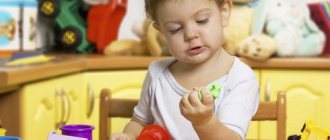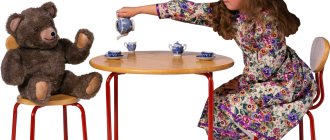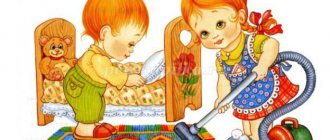All children love animals. Usually at the age of 6-8 years, a child begins to ask his parents to buy him a kitten, a puppy, a guinea pig, a hamster - anyone, just some kind of live animal, because children highly value communication with animals. But many adults see only problems in the appearance of a four-legged friend at home.
The possible manifestation of aggression on the part of the animal towards the baby and the need to constantly care for and clean up after the pet are frightening.
However, if you choose an animal that suits the child’s age, character and interests, then most unpleasant moments can be avoided.
The role of animals in the development of children
Pedagogical aspect
Children and dogs A pet is not only a source of warmth, affection and a friend, but also has a huge impact on the development of a child. Next to a four-legged friend, a child learns to be organized and disciplined. A pet teaches a child to be responsible for others. The child realizes that an animal is not a toy and needs to be looked after, fed, and walked every day. Communication skills with a pet will help a child in adulthood; he will learn to be responsible for his actions. Depending on the age of the child, the degree of responsibility in relation to the pet is determined.
So, at the age of 3 years, a child can walk a dog or cat with his parents, help pour out food, and make sure that the animal always has clean water to drink. A child of 7-9 years old can already be trusted to walk his small four-legged friend on his own. At 14-15 years old, a child can become the owner of an animal and bear most of the responsibility for it.
Social adaptation
The role of animals in the lives of children A four-legged friend for a child is the best psychologist and assistant in matters of social adaptation. Children who have a dog are easier than others to join a new team and make friends. A dog can help a shy child make contact with peers in the yard and find friends.
Neighboring children will definitely start asking about the animal, trying to play with it, and thus communication between the children will begin on its own. Walking a pet together can bring even the most taciturn children together.
Physical development
A pet contributes to the physical development of a child. When a child walks with a dog, plays ball with it, he is in constant motion, he develops proper coordination. In addition, communication with animals relieves stress and helps improve family relationships.
Intellectual development
A pet helps a child get to know the world around him. A four-legged friend is the source of the first knowledge about nature. The child observes the pet, its behavior, notes its reaction to stroking and various commands. The animal is also of great importance in the development of sensory perception in a child. Through the senses, the child perceives objects and learns to name them: shape, size, color, smell, movement, texture of fur, location, etc.
Communication with a pet also develops logical thinking. The child learns to see connections and dependencies. For example, if a cat stands by the bowl and meows, it means she is hungry; if a dog rushes to the door, jumps up and wags its tail, it means it wants to go for a walk. An animal is a source of various types of activities, as a result of which the child develops observation, curiosity, and develops imagination.
Moral development
An animal allows a child to experience his first experiences and joys. A four-legged friend gives rise to positive emotions, which is very important, because in the modern world it is precisely positive experiences that are most lacking. By interacting with a pet, a child develops a sense of beauty and learns to see natural beauty. The caring and caring attitude towards a pet that a child shows is transferred to him and the entire animal world as a whole.
Checklist before getting a pet
- Discuss purchasing a pet with your entire family in advance. It will be unpleasant to find out that the baby wanted a rabbit, not a puppy, and the grandmother is allergic to a kitten;
- Try to collect as much information as possible about the animal. Read “breed” forums and be sure to consult with experienced friends, especially if they have children;
- Choose the breeder carefully: do not chase the low price and make sure that the animal has all the documents;
- Prepare a place for your future pet before you bring him home. Buy food, bowls, toys, arrange a sleeping area;
- Find out where the nearest veterinary clinic is located. This information may not be needed, but you must own it;
- If you are getting a dog, consider a training course. Your four-legged friend will be taught basic commands and will be helped to develop the right attitude towards his owners;
- Discuss with your child in advance how to communicate with the new family member.
Which pet to choose for a child?
Child 3-4 years old
At this age, the baby actively explores the world around him. You can already have a pet, but adults will have to take care of it for now. For children 3-4 years old, it is better to have aquarium fish, a parrot, a hamster, a guinea pig or a rabbit. The child must first be told about the animal’s habits and characteristic features.
At first, the child will simply observe how the parents care for the pet, and then gradually become involved in the care process. It should be remembered that children are capable of showing their interest in living creatures in the most unexpected forms: taking a fish out of the aquarium to hold it in their hands, petting a bird, washing a hamster. Therefore, adults should always be careful and not allow children to perform such actions. It is necessary to explain to the child that this cannot be done, otherwise the pet may get sick.
Child 5-6 years old
At this age, the child's responsibilities for caring for a pet may expand. At 5-6 years old, you can already be trusted to wash the drinking bowls, pour the food yourself and pour water into the bowl. But for now, the child must do all this under the supervision of adults. For children of this age, you can get aquarium fish, birds, guinea pigs, rabbits, and hamsters.
Child 7-8 years old
Children at this age can take care of a pet almost independently. It will be very useful to read stories about animals, in which children can learn new information about the habits and characteristics of various representatives of the animal world. Adults should make it clear to children that animals need to be provided with conditions that are close to natural, and they need to be fed what they eat in nature. In order for a child to gain skills in caring for different animals and to make comparative observations of their behavior, you can get several pets, for example, a parrot and fish. At primary school age, a child can have the same animals as for earlier ages, as well as a dog or cat. But caring for four-legged animals should not yet be completely transferred to the child.
Children and animals: safety precautions
It’s done: a child and a pet live together! As we have already said, it is important not to separate them, but to give them the opportunity to communicate and interact. A baby under one year old can be allowed to pet your pet under your supervision and play catch with him. After a year, the child can use special toys for animals - balls, bows on a string, squeakers. And after 2 years, you can and should involve your baby in caring for your pet.
A small child, especially one prone to allergies, should not feed aquarium fish. Many foods, such as daphnia and gammarus, can be very irritating.
Here's what you need to consider to make communication between a child and an animal not only enjoyable, but also safe:
- Vaccinate your pet regularly and show it to the veterinarian - some infections can be transmitted from animals to humans;
- Never leave a small child and a pet alone, even if they have been friends for a long time. Sudden aggression can occur on both sides;
- Explain to your child that the animal should not be teased, distracted from food, hugged or disturbed sharply, or woken up during sleep;
- If you suspect that your baby is allergic to a pet, immediately consult a doctor and get the necessary tests done. If the allergy is confirmed, you may have to part with the animal. But sometimes the problem can be solved with careful hygiene, daily cleaning and special air purifiers;
- Be prepared for the fact that the animal may perceive the child as lower in the family hierarchy and behave accordingly. As a rule, you can establish the right rules with the help of a specialist (canine handler, zoopsychologist), but if you feel a real threat from an animal, consider “retreat routes.”
If there are allergy sufferers in the family, initially choose “safe” breeds of animals. Among dogs these are Maltese dogs and Yorkshire terriers, among cats - Sphynxes and Orientals.
Things to think about before getting a pet
First of all, you need to understand that you are getting a pet not only for your child, but also for yourself. If the child is still small, then most of the responsibilities for caring for the pet will fall on your shoulders. Think about whether you are ready to take on a new burden of responsibility and new worries. By getting an animal, you are getting a new family member who will require not only a lot of attention and time, but also certain financial expenses. It is also worth considering whether your living conditions allow you to have a pet.
If you live in your own home, you can have any animal. And in a small apartment, even fish may not find a suitable place. If you are still not ready to keep a pet, then it is better not to get one. Otherwise, when you decide to give the animal away, it can be a big tragedy for both the child and the pet.
Dangers from Pets
Animals can be dangerous to children. First of all, it's an allergy. If a child or someone in the house is prone to allergic reactions, it is not recommended to get an animal.
Also, many animals are carriers of various infections that a child can very easily catch. Therefore, if you get a pet, you need to periodically show it to the veterinarian and take the necessary tests. The danger can also come from large breed dogs. Such dogs are physically stronger than a child, so it is better not to have them.
It is also not recommended to have dogs with an unbalanced psyche. If you choose the right pet, take a responsible approach to raising it, and provide careful care, then all dangers can be minimized.
Weigh the pros and cons and choose the pet that is best for your child. Believe me, this will be the best gift for him! Good luck!
What should you be wary of?
Parents who are categorically against pets around their children are primarily guided by the danger that pets can cause to their children.
Disadvantages of pets in a home with children:
- Small kittens and puppies are often scratched by their thin claws. Even small scratches can cause the development of felinosis. Bacteria enter the wound, causing discomfort and pain. Scratches take a long time to heal and can fester.
- Cats are carriers of such a dangerous disease as toxoplasmosis. It is especially scary when toxoplasmosis is detected during pregnancy. Some doctors believe that a pregnant woman who has grown up with cats since childhood has a minimal risk of developing toxoplasmosis. This is explained by the fact that protective immunity was formed in her body many years ago. However, the disease is dangerous for those who suffer from chronic diseases and low immunity. But it should be noted that many people are carriers of toxoplasmosis, and this does not affect their health in any way.
- A dog can get rabies, and this is a dangerous disease for people and fatal for the pet itself. Dogs usually become infected with rabies through the bites of stray dogs, so you need to walk your pet in specially designated areas and regularly get vaccinated against rabies.
- Many people believe that children can get worms if they have close contact with animals. But some researchers say animal worms are not transmitted to humans. In any case, parents need to regularly get tested for the presence of worms in the whole family. If worms are detected, you must contact your pediatrician, who will prescribe treatment. In addition, pets also need to be given anti-worm medications as a preventive measure.
- A child prone to allergic reactions may develop an allergy to wool. Fortunately, there are breeds of dogs and cats that do not cause allergy attacks. American veterinarians say that it is absolutely safe to have Sphynx cats, as well as poodles, Bichon Frize, Portuguese Water Dog, almost all types of terriers, and Chinese Crested cats in a home with children with allergies.
If it is impossible to have an animal
If for some reason you cannot or do not want to have a pet, do not be discouraged: there are many opportunities to provide your child with interaction with animals.
Look out for petting zoos or farms where your little one will be allowed to pet a llama, feed a baby goat, or hold a bunny. In horse clubs, most often you can just take a walk and feed the horses carrots. Don’t forget about kennels for sled dogs, such as huskies: their owners not only let you ride in a sled, but also play with their animals. Another good option is regular trips to visit friends and relatives who have pets. Remember that communication with the animal world is very useful for the development and socialization of a child, and try to organize this communication!
Article on our Yandex.Zen channel
Are there any alternatives to purchasing?
It also happens that it is completely impossible to have a pet for a child, but the child is very drawn to animals. Remember that purchasing an animal is not always the only possible option: ask your friends if it is possible to join them for a walk with the dog, visit exhibitions and competitions, go to a zoo, reserve or ecological settlement, older children can be enrolled in training courses, in a youth club zoologists or riding school. However, do not forget about safety and do not allow your child to come into contact with unfamiliar animals, as this may result in injury.
Recently, many petting zoos have been opening in cities, where you can feed and pet different animals. Good institutions (usually located at zoological centers) can give the child the opportunity to interact with animals. Beware of places where no one controls or regulates the interaction of children with pets, and the animals themselves do not look healthy and calm. In such zoos, you will not only endanger your child, but also introduce him to cruelty to animals. For the same reason, circuses are not suitable for getting to know wildlife: in them, four-legged performers are in unnatural conditions and are subject to constant stress.
Choosing a pet
If you do decide to get your own pet, take the time to carefully study what type and breed of animal is right for your family and allow children to actively participate in the selection and preparation process, because this part can also teach the child a lot: take them with together to meet breeders, to exhibitions, and read the necessary literature together.
Dogs are undoubtedly the most difficult pets to care for. However, it is from them that we receive the most emotional support; it is among dog lovers that various activities with the participation of four-legged friends are most developed (dancing with dogs, exhibitions, grooming, various types of training, skiing, competitions in catching plates and balls, etc.). d.) We recommend getting a dog for active families who are open to new hobbies and acquaintances, who are attracted to active recreation and those who have time to raise and care for their pet. When choosing a dog, pay special attention to its character: study the description of the breed and the behavior of specific candidates. If possible, ask a specialist for help in choosing a pet, because cowardly and aggressive dogs can be dangerous for all family members.
Cats are more independent animals, they require less interaction with humans and their own kind, and they require less time for care. However, it should be remembered that, unlike dogs, cats are more attached to a place, so it is more difficult for them to endure moving and temporary foster care. In addition, cats often cause allergies, which can be a serious obstacle.
Birds (especially parrots) can teach a child a lot. They have a variety of behavior, some of them are very social and are excellent at remembering their owner. The noise the birds make and the size of the cage space may be a problem.
Lately, more and more often rodents are becoming children's first pets. They are social animals that are fun to watch, many are trainable, require relatively little space and time to care for, and have a shorter lifespan than cats and dogs.
Turtles often end up in families with children. Their disadvantage is that they no longer show their emotions so clearly and clearly and do not demonstrate affection for their owner, but, nevertheless, they are interesting and easy to care for.
An interesting choice could be purchasing crabs, snails or insects: ant farms, which children love to watch, are becoming increasingly popular; children are often given hermit crabs in colorful shells and huge snails. It is interesting not only to watch such animals, but also to arrange their home, collecting branches and fancy leaves for a terrarium.
We strongly discourage keeping wild animals at home: they do not know how to communicate with people and are in constant stress around humans, for this reason they are most often extremely aggressive. Don't believe exotic pet sellers who claim otherwise!
Whatever pet you choose, try to find out as much information about it as possible from different sources: what are the differences between breeds, what kind of activity mode does the animal have, what conditions are required, how much does it cost to maintain. Never buy animals from your local pet store, they may be sick. Make a choice in favor of professional breeders: they will provide the necessary documents and veterinary certificates, will be happy to give recommendations for care, and warn about possible problems. If possible, try to visit several breeders so that you can compare animals and make a choice in favor of the most suitable option. Don’t be afraid to sign up for the waiting list for unborn litters—a responsible decision cannot be rushed, and waiting will give you time to think it over again.
Options for pets don't end with cats and dogs; sometimes it's more useful to take a closer look at smaller animals: rodents, birds, turtles and even insects. They require less attention and are cheaper to maintain, although they also have less emotional impact. In any case, before purchasing an animal you should carefully weigh the pros and cons.
Why do we get animals?
Man domesticated wild animals thousands of years ago, and from that moment on, the life of our ancestors was closely connected with them. However, it should be noted that the role of animals in people’s lives has changed greatly: from using them as a living instrument to literally elevating them to the status of an equal member of the family.
Modern families most often get animals to enjoy communicating with them, as a fashion or status element, for protection or use in work, often, consciously or not, animals replace the missing family member.
Usually people are confused if you ask them why they need a pet. This happens because our emotional impulses are often difficult to describe in words, but the situation with animals is exactly this: we get them to expand our social circle, not to feel lonely, to have someone nearby in whom we can be confident, to feel love and gratitude to you.
Often families answer that they got an animal for their child. We believe that caring for a pet will teach a child responsibility and make him more sociable and kind. But is this so and under what conditions will real friendship develop between a child and his pet?









